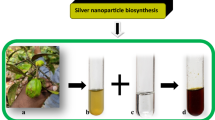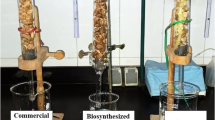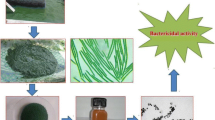Abstract
The topic of this investigation was to evaluate the microbial contamination of household sponges, biosynthesize of silver nanoparticles (Ag NPs) by Gliocladium deliquescens cell-free supernatant, and estimate the efficiency of Ag NPs as an acceptable disinfectant. The 23 factorial design was applied for the optimization of Ag NPs synthesis. Silver nitrate (AgNO3) concentration was the main positive impact on Ag NP biosynthesis. Various gamma irradiation doses were used in Ag NP production where the highest yield production was at 25.0 kGy. Ag NPs were characterized by UV–Vis. spectroscopy, The Fourier-transform infrared spectroscopy analysis (FTIR), dynamic light scattering (DLS), X-ray diffraction (XRD), and transmission electron microscope (TEM). Ag NPs were monodispersed spherical-shaped with 9.68 nm mean size. Two hundred sponge samples that were collected from different Egyptian household furniture and kitchens were highly contaminated by various contaminants including Salmonella spp., Staphylococcus spp., coliform bacteria, Gram-negative bacteria, yeasts, and molds. Ag NPs showed functional antimicrobial activity against all the microbial contaminants; Salmonella spp. was completely inhibited by Ag NP (50.0 μg/mL) treatment. The Ag NPs have the maximum inhibition zone against Salmonella spp. (14 mm) compared with the Staphylococcus spp. (12.3 mm). The minimum inhibitory concentration (MIC) of Ag NPs against Salmonella spp. and Staphylococcus spp. were 6.25 μg/ mL and 12.5 μg/ mL, respectively. The antibiofilm activity of Ag NPs was the highest at the concentration of 50.0 μg/mL recording 63.3 % for Salmonella spp. and 54.5 % for Staphylococcus spp. Ag NPs may find potent disinfectant applications for household purposes.








Similar content being viewed by others
References
Guo J-Z, Cui H, Zhou W, Wang W (2008) Ag nanoparticle-catalyzed chemiluminescent reaction between luminol and hydrogen peroxide. J Photochem Photobiol 193(2-3):89–96
Lansdown AB (2006) Silver in health care: antimicrobial effects and safety in use. In: Biofunctional textiles and the skin, vol 33. Karger Publishers, pp 17–34
Mueller NC, Nowack B (2008) Exposure modeling of engineered nanoparticles in the environment. Environ Sci Technol 42(12):4447–4453
El-Batal AI, El-Sayyad GS, Mosallam FM, Fathy RM (2019) Penicillium chrysogenum-mediated mycogenic synthesis of copper oxide nanoparticles using gamma rays for in vitro antimicrobial activity against some plant pathogens. J Clust Sci:1–12
Sondi I, Salopek-Sondi B (2004) Silver nanoparticles as antimicrobial agent: a case study on E. coli as a model for Gram-negative bacteria. J Colloid Interface Sci 275(1):177–182
Jung WK, Koo HC, Kim KW, Shin S, Kim SH, Park YH (2008) Antibacterial activity and mechanism of action of the silver ion in Staphylococcus aureus and Escherichia coli. Appl Environ Microbiol 74(7):2171–2178
Wright J, Lam K, Hansen D, Burrell R (1999) Efficacy of topical silver against fungal burn wound pathogens. Am J Infect Control 27(4):344–350
Okafor F, Janen A, Kukhtareva T, Edwards V, Curley M (2013) Green synthesis of silver nanoparticles, their characterization, application and antibacterial activity. Int J Environ Res Public Health 10(10):5221–5238
Bonsak J, Mayandi J, Thøgersen A, Stensrud Marstein E, Mahalingam U (2011) Chemical synthesis of silver nanoparticles for solar cell applications. Phys Status Solidi 8(3):924–927
Zhang G, Liu Y, Gao X, Chen Y (2014) Synthesis of silver nanoparticles and antibacterial property of silk fabrics treated by silver nanoparticles. Nanoscale Res Lett 9(1):216
Ismail A-WA, Sidkey NM, Arafa RA, Fathy RM, El-Batal AI (2016) Evaluation of in vitro antifungal activity of silver and selenium nanoparticles against Alternaria solani caused early blight disease on potato. Br Biotechnol J 12(3):1
Cho I-H, Ku S (2017) Current technical approaches for the early detection of foodborne pathogens: Challenges and opportunities. Int J Mol Sci 18(10):2078
Cinti S, Volpe G, Piermarini S, Delibato E, Palleschi G (2017) Electrochemical biosensors for rapid detection of foodborne Salmonella: A critical overview. Sensors 17(8):1910
El-Batal A, El-Baz A, Abo Mosalam F, Tayel A (2013) Gamma irradiation induces silver nanoparticles synthesis by Monascus purpureus. J Chem Pharm Res 5(8):1–15
El-Batal AI, El-Sayyad GS, El-Ghamery A, Gobara M (2017) Response surface methodology optimization of melanin production by Streptomyces cyaneus and synthesis of copper oxide nanoparticles using gamma radiation. J Clust Sci 28(3):1083–1112
Liao S, Zhang Y, Pan X, Zhu F, Jiang C, Liu Q, Cheng Z, Dai G, Wu G, Wang L (2019) Antibacterial activity and mechanism of silver nanoparticles against multidrug-resistant Pseudomonas aeruginosa. Int J Nanomedicine 14:1469
El-Batal AI, Sidkey NM, Ismail A, Arafa RA, Fathy RM (2016) Impact of silver and selenium nanoparticles synthesized by gamma irradiation and their physiological response on early blight disease of potato. J Chem Pharm Res 8(4):934–951
Golińska P, Wypij M, Rathod D, Tikar S, Dahm H, Rai M (2016) Synthesis of silver nanoparticles from two acidophilic strains of Pilimelia columellifera subsp. pallida and their antibacterial activities. J Basic Microbiol 56(5):541–556
Josephson K, Rubino J, Pepper I (1997) Characterization and quantification of bacterial pathogens and indicator organisms inhousehold kitchens with and without the use of a disinfectant cleaner. J Appl Microbiol 83(6):737–750
Szita G, Gyetvai B, Szita J, Gyenes M, Solymos N, Soos L, Hajos A, Toth P, Bernáth S (2008) Synthetic culture media evaluated for the detection of coliform bacteria in milk, cheese and egg melange. Acta Vet Brno 77(1):143–147
Stiles M (1977) Reliability of selective media for recovery of staphylococci from cheese. Journal of Food Protection 40(1):11–16
Nesa M, Khan M, Alam M (2011) Isolation, identification and characterization of Salmonella serovars from diarrhoeic stool samples of human. Bangl J Vet Med 9(1):85–93
Horvath R, Ropp M (1974) Mechanism of action of eosin-methylene blue agar in the differentiation of Escherichia coli and Enterobacter aerogenes. Int J Syst Evol Microbiol 24(2):221–224
Lkhagvajav N, Koizhaiganova M, Yasa I, Çelik E, Sari Ö (2015) Characterization and antimicrobial performance of nano silver coatings on leather materials. Braz J Microbiol 46(1):41–48
El-Sayyad GS, Mosallam FM, El-Batal AI (2018) One-pot green synthesis of magnesium oxide nanoparticles using Penicillium chrysogenum melanin pigment and gamma rays with antimicrobial activity against multidrug-resistant microbes. Adv Powder Technol 29(11):2616–2625
Maiti S, Krishnan D, Barman G, Ghosh SK, Laha JK (2014) Antimicrobial activities of silver nanoparticles synthesized from Lycopersicon esculentum extract. Anal Sci Tech 5(1):40
Maksoud MA, El-Sayyad GS, Ashour A, El-Batal AI, Elsayed MA, Gobara M, El-Khawaga AM, Abdel-Khalek E, El-Okr M (2019) Antibacterial, antibiofilm, and photocatalytic activities of metals-substituted spinel cobalt ferrite nanoparticles. Microb Pathog 127:144–158
El-Nemr KF, Mohamed HR, Ali MA, Fathy RM, Dhmees AS (2019) Polyvinyl alcohol/gelatin irradiated blends filled by lignin as green filler for antimicrobial packaging materials. Int J Environ An Ch 1–25
Puzey K, Gardner P, Petrova V, Donnelly C, Petrucci G (2008) Automated species and strain identification of bacteria in complex matrices using FTIR spectroscopy. In: Chemical, biological, radiological, nuclear, and explosives (CBRNE) sensing IX, vol 3. International Society for Optics and Photonics, pp 1–9
Murtey MD, Ramasamy P (2016) Sample preparations for scanning electron microscopy–life sciences. Modern electron microscopy in physical and life sciences. M. Janecek. InTech, In
Kim H-Y (2014) Analysis of variance (ANOVA) comparing means of more than two groups. Restorative Dentistry & Endodontics 39(1):74–77
El-Batal AI, Mosallam FM, El-Sayyad GS (2018) Synthesis of metallic silver nanoparticles by fluconazole drug and gamma rays to inhibit the growth of multidrug-resistant microbes. J Clust Sci 29(6):1003–1015
Korbekandi H, Iravani S, Abbasi S (2012) Optimization of biological synthesis of silver nanoparticles using Lactobacillus casei subsp. casei. J Chem Technol Biotechnol 87(7):932–937
Baraka A, Dickson S, Gobara M, El-Sayyad GS, Zorainy M, Awaad MI, Hatem H, Kotb MM, Tawfic A (2017) Synthesis of silver nanoparticles using natural pigments extracted from Alfalfa leaves and its use for antimicrobial activity. Chem Pap 71(11):2271–2281
Mohanpuria P, Rana NK, Yadav SK (2008) Biosynthesis of nanoparticles: technological concepts and future applications. J Nanoparticle Res 10(3):507–517
Abd-Elnaby HM, Abo-Elala GM, Abdel-Raouf UM, Hamed MM (2016) Antibacterial and anticancer activity of extracellular synthesized silver nanoparticles from marine Streptomyces rochei MHM13. Egypt J Aquat Res 42(3):301–312
Mosallam FM, El-Sayyad GS, Fathy RM, El-Batal AI (2018) Biomolecules-mediated synthesis of selenium nanoparticles using Aspergillus oryzae fermented Lupin extract and gamma radiation for hindering the growth of some multidrug-resistant bacteria and pathogenic fungi. Microb pathog 4(11):1341–1363
Tulve NS, Stefaniak AB, Vance ME, Rogers K, Mwilu S, LeBouf RF, Schwegler-Berry D, Willis R, Thomas TA, Marr LC (2015) Characterization of silver nanoparticles in selected consumer products and its relevance for predicting children’s potential exposures. Int J Hyg Environ Health 218(3):345–357
Mohammadian A, Shojaosadati S, Habibi Rezaee M (2007) Fusarium oxysporum mediates photogeneration of silver nanoparticles. Sci Iran 14(4):323–326
Chowdhury S, Yusof F, Faruck MO, Sulaiman N (2016) Process optimization of silver nanoparticle synthesis using response surface methodology. Procedia Eng 148:992–999
Le Caër S (2011) Water radiolysis: influence of oxide surfaces on H2 production under ionizing radiation. Water 3(1):235–253
Madhukumar R, Byrappa K, Wang Y, Sangappa Y (2018) Effect of gamma irradiation on synthesis and characterization of bio-nanocomposite SF/Ag nanoparticles. Radiat Eff Defect S :1–7
El-Batal A, Haroun BM, Farrag AA, Baraka A, El-Sayyad GS (2014) Synthesis of silver nanoparticles and incorporation with certain antibiotic using gamma irradiation. Br J Pharm Res 4(11):1341–1363
Ammar H, El-Desouky T (2016) Green synthesis of nanosilver particles by Aspergillus terreus HA1N and Penicillium expansum HA2N and its antifungal activity against mycotoxigenic fungi. J Appl Microbiol 121(1):89–100
El-Baz AF, El-Batal AI, Abomosalam FM, Tayel AA, Shetaia YM, Yang ST (2016) Extracellular biosynthesis of anti-Candida silver nanoparticles using Monascus purpureus. J Basic Microbiol 56(5):531–540
Priyadarshini S, Gopinath V, Priyadharsshini NM, MubarakAli D, Velusamy P (2013) Synthesis of anisotropic silver nanoparticles using novel strain, Bacillus flexus and its biomedical application. Colloid Surface B 102:232–237
Kumar V, Yadav SC, Yadav SK (2010) Syzygium cumini leaf and seed extract mediated biosynthesis of silver nanoparticles and their characterization. J Chem Technol Biotechnol 85(10):1301–1309
Suresh AK, Pelletier DA, Wang W, Broich ML, Moon J-W, Gu B, Allison DP, Joy DC, Phelps TJ, Doktycz MJ (2011) Biofabrication of discrete spherical gold nanoparticles using the metal-reducing bacterium Shewanella oneidensis. Acta Biomater 7(5):2148–2152
Gudikandula K, Vadapally P, Charya MS (2017) Biogenic synthesis of silver nanoparticles from white rot fungi:Their characterization and antibacterial studies. OpenNano 2:64-78
Adebayo-Tayo BC, Popoola AO, Ajunwa OM (2017) Bacterial synthesis of silver nanoparticles by culture free supernatant of lactic acid bacteria isolated from fermented food samples. Biotechnol J Int 19(1):1–13
Oza G, Pandey S, Shah R, Sharon M (2012) Extracellular fabrication of silver nanoparticles using Pseudomonas aeruginosa and its antimicrobial assay. Pelagia Res Lib Adv Appl Sci Res 3(3):1778–1783
Pulit-Prociak J, Banach M (2016) Silver nanoparticles–a material of the future …? Open Chem 14(1):76–91
Park H-J, Kim JY, Kim J, Lee J-H, Hahn J-S, Gu MB, Yoon J (2009) Silver-ion-mediated reactive oxygen species generation affecting bactericidal activity. Water Res 43(4):1027–1032
Alaqad K, Saleh T (2016) Gold and silver nanoparticles: synthesis methods, characterization routes and applications towards drugs. J Environ Anal Toxicol 6(384):2161–0525.1000384
Dakal TC, Kumar A, Majumdar RS, Yadav V (2016) Mechanistic basis of antimicrobial actions of silver nanoparticles. Front Microbiol 7:1831
Morones JR, Frey W (2007) Environmentally sensitive silver nanoparticles of controlled size synthesized with PNIPAM as a nucleating and capping agent. Langmuir 23(15):8180–8186
Buszewski B, Railean-Plugaru V, Pomastowski P, Rafinska K, Szultka-Mlynska M, Kowalkowski T (2017) Antimicrobial effectiveness of bioactive silver nanoparticles synthesized by Actinomycetes HGG16n Strain. Curr Pharm Biotechnol 18(2):168–176
Peiris MK, Gunasekara CP, Jayaweera PM, Arachchi ND, Fernando N (2017) Biosynthesized silver nanoparticles: are they effective antimicrobials? Memórias do Instituto Oswaldo Cruz 112(8):537–543
Romero-Urbina DG, Lara HH, Velázquez-Salazar JJ, Arellano-Jiménez MJ, Larios E, Srinivasan A, Lopez-Ribot JL, Yacamán MJ (2015) Ultrastructural changes in methicillin-resistant Staphylococcus aureus induced by positively charged silver nanoparticles. Beilstein J Nanotechnol 6:2396
Kawai S, Phan TA, Kono E, Harada K, Okai C, Fukusaki E, Murata K (2009) Transcriptional and metabolic response in yeast Saccharomyces cerevisiae cells during polyethylene glycol-dependent transformation. J Basic Microbiol 49(1):73–81
Donlan RM (2002) Biofilms: microbial life on surfaces. Emerg infect dis 8(9):881–890
Iñiguez-Moreno M, Gutiérrez-Lomelí M, Guerrero-Medina PJ, Avila-Novoa MG (2018) Biofilm formation by Staphylococcus aureus and Salmonella spp. under mono and dual-species conditions and their sensitivity to cetrimonium bromide, peracetic acid and sodium hypochlorite. Braz J Microbiol 49(2):310–319
Janssens JC, Steenackers H, Robijns S, Gellens E, Levin J, Zhao H, Hermans K, De Coster D, Verhoeven TL, Marchal K (2008) Brominated furanones inhibit biofilm formation by Salmonella enterica serovar Typhimurium. Appl Environ Microbiol 74(21):6639–6648
Duarte A, Alves AC, Ferreira S, Silva F, Domingues FC (2015) Resveratrol inclusion complexes: antibacterial and anti-biofilm activity against Campylobacter spp. and Arcobacter butzleri. Food Res Int 77:244–250
O’toole GA, Kolter R (1998) Flagellar and twitching motility are necessary for Pseudomonas aeruginosa biofilm development. Mol Microbiol 30(2):295–304
Preisner O, Guiomar R, Machado J, Menezes JC, Lopes JA (2010) Application of Fourier transform infrared spectroscopy and chemometrics for differentiation of Salmonella enterica serovar Enteritidis phage types. Appl Environ Microbiol 76(11):3538–3544
Filip Z, Hermann S, Demnerová K (2009) FT-IR spectroscopic characteristics of differently cultivated Escherichia coli. Czech J Food Sci 26(6):458–463
Kamnev A, Antonyuk L, Tugarova A, Tarantilis P, Polissiou M, Gardiner P (2002) Fourier transform infrared spectroscopic characterisation of heavy metal-induced metabolic changes in the plant-associated soil bacterium Azospirillum brasilense Sp7. J Mol Struct 610(1-3):127–131
Mishra P, Tyagi S, Tripathi D (2019) Comparative evaluation of silver nanoparticles and 5.25% sodium hypochlorite for rapid chairside decontamination of artificially infected gutta-percha with Escherichia coli: an in vitro Study. Density Med Res 7:1–23
Abdel-Rahman HA, Awad EH, Fathy RM (2019) Effect of modified nano zinc oxide on physico-chemical and antimicrobial properties of gamma-irradiated sawdust/epoxy composites. J Compos Mater. https://doi.org/10.1177/0021998319863835
Kim, S. H., Lee, H. S., Ryu, D. S., Choi, S. J., and Lee, D. S. (2011) Antibacterial Activity of Silver-nanoparticles Against Staphylococcus aureus and Escherichia coliKorean J. Microbiol. Biotechnol. 39, 77–85.
Acknowledgments
The authors would like to thank P.I. Prof. Dr. Ahmed Ibrahim El-Batal, Drug Microbiology Lab, Drug Radiation Research Department, NCRRT, Cairo, Egypt, for supporting this study. Also, the authors thank greatly Dr. Gharieb Saied El-Sayyad for his valuable guidance during this investigation.
Author information
Authors and Affiliations
Corresponding author
Ethics declarations
Permissions were obtained for collection of samples from the responsible authorities of the household were indicated previously.
Conflict of Interest
The authors declare that they have no conflict of interest.
Research involving Human Participation and/or Animals
Not applicable.
Informed consent
Applicable.
Ethical approval
Applicable.
Additional information
Publisher’s Note
Springer Nature remains neutral with regard to jurisdictional claims in published maps and institutional affiliations.
Rights and permissions
About this article
Cite this article
Fathy, R.M., Salem, M.S.Ed. & Mahfouz, A.Y. Biogenic synthesis of silver nanoparticles using Gliocladium deliquescens and their application as household sponge disinfectant. Biol Trace Elem Res 196, 662–678 (2020). https://doi.org/10.1007/s12011-019-01958-2
Received:
Accepted:
Published:
Issue Date:
DOI: https://doi.org/10.1007/s12011-019-01958-2




